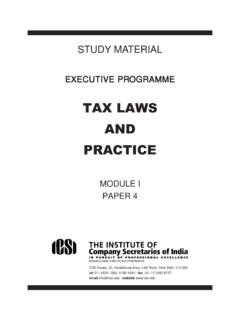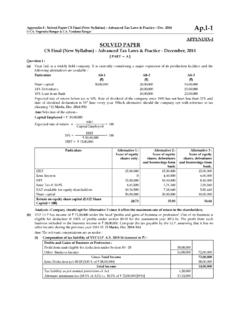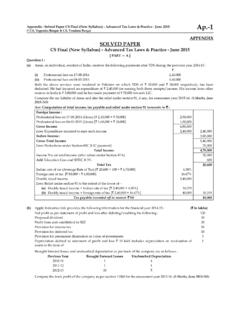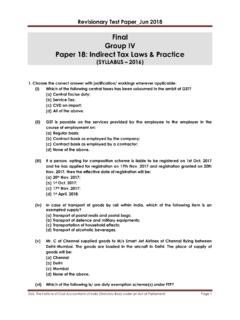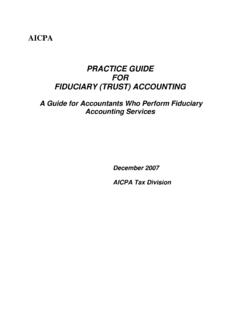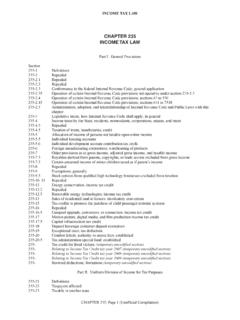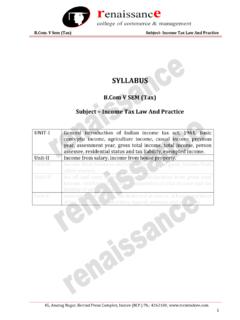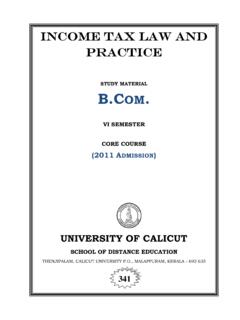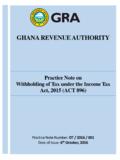Transcription of Frequently Asked Questions About Tax Reform - …
1 Frequently Asked Questions About Tax Reform Introduction On December 22, 2017, President Trump signed into law the tax legislation commonly known as the Tax Cuts and Jobs Act (the Act ).1 Under ASC 740,2 the effects of new legislation are recognized upon enactment, which (for federal legislation) is the date the president signs a bill into law. Accordingly, recognition of the tax effects of the Act is required in the interim and annual periods that include December 22, 2017. This Financial Reporting Alert (FRA) contains responses to Frequently Asked Questions (FAQs) About how an entity should account for the tax effects of the Act in accordance with ASC 740. While the answers to the FAQs reflect our current views, these views are subject to change on the basis of additional input received or further developments in practice.
2 We plan to continue to update this document to reflect developments as they occur and as additional Questions surface. The following is a high-level summary of the updates to this FRA thus far: Originally issued on January 3, 2018. Updated on January 19, 2018, to address a number of additional FAQs and to reflect the activities of the FASB and its staff. Updated on March 20, 2018, to cover a number of additional FAQs ( , a new section on interim considerations was added) and to incorporate guidance that previously appeared separately in FRAs 18-3 and 1/Public Law 115-97, An Act to provide for reconciliation pursuant to titles II and V of the concurrent resolution on the budget for fiscal year 2018. 2 For titles of FASB Accounting Standards Codification (ASC) references, see Deloitte s Titles of Topics and Subtopics in the FASB Accounting Standards Codification.
3 Financial Reporting Alert 18-1 January 3, 2018 (Last updated June 20, 2018)Contents Introduction SAB 118 FASB ASU and Q&As (Updated June 20, 2018) Change in Corporate Tax Rate Modification of Carryforwards and Certain Deductions Deemed Repatriation Transition Tax (IRC Section 965) Global Intangible Low-Taxed Income Foreign-Derived Intangible Income Base Erosion Anti-Abuse Tax Corporate AMT Non ASC 740 Topics Affected by Tax Reform2 Updated on June 20, 2018, principally to provide a new section related to the adoption of ASU and added FAQs are marked as such in the question 118 Shortly after enactment, the SEC staff issued SAB 118,3 which provides guidance on accounting for the Act s impact. Under SAB 118, an entity would use something similar to the measurement period in a business combination.
4 That is, an entity would recognize those matters for which the accounting can be completed ( Bucket 1 ), as might be the case for the effect of rate changes on deferred tax assets (DTAs) and deferred tax liabilities (DTLs). For matters that have not been completed, the entity would either (1) recognize provisional amounts to the extent that they are reasonably estimable and adjust them over time as more information becomes available ( Bucket 2 ) or (2) for any specific income tax effects of the Act for which a reasonable estimate cannot be determined, continue to apply ASC 740 on the basis of the provisions of the tax laws that were in effect immediately before the Act was signed into law that is, the entity would not adjust current or deferred taxes for those tax effects of the Act until a reasonable estimate can be determined ( Bucket 3 ).
5 I. How do SAB 118 and the need to record reasonable estimates interact with the guidance in ASC 740 regarding uncertain tax positions ( , FIN 48) with respect to the Act? [Added March 20, 2018]SAB 118 addresses certain practical problems created by the enactment of a vast amount of new and complex legislation only nine days before December 31, 2017 the end of a reporting period for most entities. The Act was developed over a very condensed timeframe, and preparers and practitioners had little time to analyze its preliminary or final versions. As a consequence, there may be tax technical matters with respect to the Act for which it is not feasible to prepare a complete more-likely-than-not assessment during the enactment period or potentially even in subsequent quarters within the measurement period.
6 Accordingly, we believe that uncertainties About how the Act should be interpreted may be accounted for provisionally under SAB 118. More specifically, during the one-year measurement period, an entity may account for an uncertain tax technical matter with respect to the Act on the basis of a reasonable estimate of how the Act will ultimately be interpreted. As new information becomes available, an entity would then adjust its provisional estimate until it can complete its more-likely-than-not assessment. It would need to complete that assessment, along with appropriate measurement of the resulting positions, by the end of the measurement period. In a manner consistent with SAB 118, an entity should make a good faith effort to develop reasonable estimates until it prepares a complete more-likely-than-not whether a tax technical matter is within the scope of SAB 118 during the one-year measurement period will, of course, depend on the specific facts and circumstances of each individual entity and will require considerable ASU and Q&As (Updated June 20, 2018)Since the Act was signed into law, the FASB has issued the following new guidance on accounting for certain aspects of it: Staff Q&A (January 2018) stating that entities that are not SEC registrants may apply SAB 118 to financial SEC Staff Accounting Bulletin No.
7 118. Separate-Company Financial Statements Disclosure Considerations IFRS Considerations Interim Reporting Considerations ASU 2018-02 Upcoming Dbriefs WebcastJoin us on June 26 at 2:00 EDT for a Dbriefs webcast, Quarterly Accounting Roundup: Q2 2018 Update on Important Developments. 3 Four staff Q&As (January 2018) outlining the FASB staff s interpretations of ASC 740 and GAAP with respect to (1) discounting of the deemed repatriation transition tax and refundable alternative minimum tax (AMT) credit carryforwards, (2) global intangible low-taxed income (GILTI), and (3) the base erosion anti-abuse tax (BEAT). See additional discussion in FAQs , , , and ASU 2018-024 (February 2018), which addresses industry concerns About the requirement in ASC 740 that the effect of a change in tax laws or rates on DTAs and DTLs be included in income from continuing operations in the reporting period that contains the enactment date of the change.
8 That guidance applies even when the tax effects were initially recognized directly in other comprehensive income (OCI) at the previous rate, resulting in stranded amounts in accumulated other comprehensive income (AOCI) related to the income tax rate differential. See additional discussion in FAQs through in Corporate Tax RateThe Act reduces the corporate tax rate to 21 percent, effective January 1, 2018, for all corporations. Because ASC 740-10-25-47 requires the effect of a change in tax laws or rates to be recognized as of the date of enactment, all corporations, regardless of their year-end, must adjust their DTAs and DTLs as of December 22, 2017. The effect of changes in tax laws or rates on DTAs or DTLs is allocated to continuing operations as a discrete item rather than through the annual effective tax rate (AETR).
9 For calendar-year-end entities, what is the impact of the change in the corporate tax rate on DTAs and DTLs that exist as of the enactment date? DTAs and DTLs that exist as of the enactment date and are expected to reverse after the Act s effective date (January 1, 2018, for calendar-year-end entities) should be adjusted to the new statutory tax rate of 21 percent. Any DTAs and DTLs expected to reverse before the Act s effective date should not be adjusted to the new statutory tax If some deferred tax balances are attributable to items of pretax comprehensive income or loss other than continuing operations ( , discontinued operations, OCI, or items charged or credited directly to equity), should the adjustment for the effect of the tax rate change still be allocated to continuing operations?
10 [Amended January 19, 2018]Yes. Under ASC 740-10-45-15, the tax effects of changes in tax laws or rates are allocated to income from continuing operations irrespective of the source of the income or loss to which the deferred tax item is related. In a manner consistent with ASC 740-10-30-26, the tax effects of items not included in continuing operations that arose before the enactment date are measured on the basis of the enacted rate at the time the transaction was recognized. (For more information, see Sections and of Deloitte s A Roadmap to Accounting for Income Taxes.) [Amended and renumbered to FAQ on June 20, 2018]4 FASB Accounting Standards Update No. 2018-02, Income Statement Reporting Comprehensive Income (Topic 220): Reclassification of Certain Tax Effects From Accumulated Other Comprehensive How should a reporting entity compute its temporary differences as of the enactment date when measuring its DTAs and DTLs?











